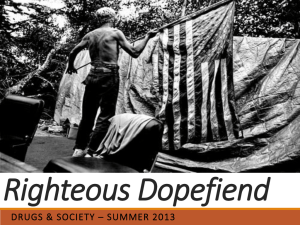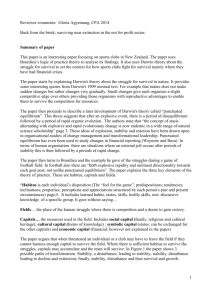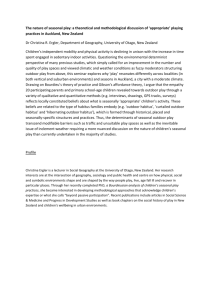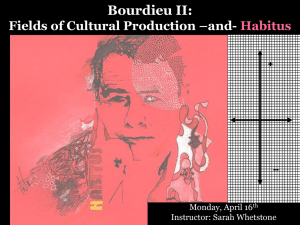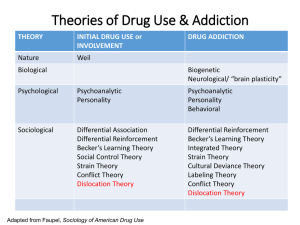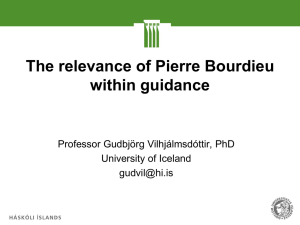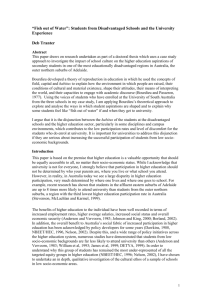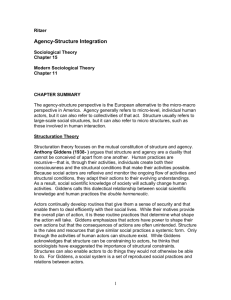In the Habitus of the New Structure, agency and the social media
advertisement
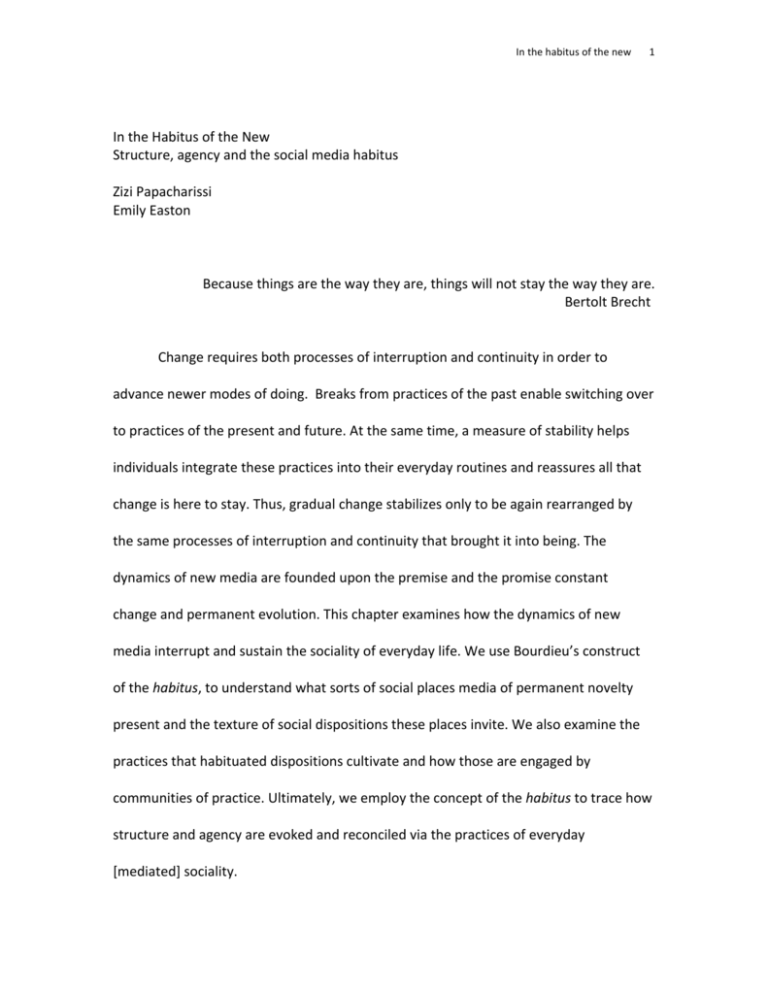
In the habitus of the new 1 In the Habitus of the New Structure, agency and the social media habitus Zizi Papacharissi Emily Easton Because things are the way they are, things will not stay the way they are. Bertolt Brecht Change requires both processes of interruption and continuity in order to advance newer modes of doing. Breaks from practices of the past enable switching over to practices of the present and future. At the same time, a measure of stability helps individuals integrate these practices into their everyday routines and reassures all that change is here to stay. Thus, gradual change stabilizes only to be again rearranged by the same processes of interruption and continuity that brought it into being. The dynamics of new media are founded upon the premise and the promise constant change and permanent evolution. This chapter examines how the dynamics of new media interrupt and sustain the sociality of everyday life. We use Bourdieu’s construct of the habitus, to understand what sorts of social places media of permanent novelty present and the texture of social dispositions these places invite. We also examine the practices that habituated dispositions cultivate and how those are engaged by communities of practice. Ultimately, we employ the concept of the habitus to trace how structure and agency are evoked and reconciled via the practices of everyday [mediated] sociality. In the habitus of the new 2 The habitus is perhaps one of Bourdieu’s most popular ideas, developed to overcome a number of binary divisions in the social sciences, and in particular, to address the duality of structure and agency. In explicating this relationship, Giddens (1979) underscored that “social structures are both constituted by human agency, and yet at the same time are the very medium of this constitution” (p. 121). Broadly defined as a set of durable dispositions that enable structured improvisations of individuals, all guiding social life, the habitus both invites ambiguity and flexibility in terms of how it is interpreted, perhaps by design (Park, 2009). Regardless, is it useful because it does not separate structure from agency, explaining how “embodied dispositions . . . are generated by structural features of that same social world” and “agents’ dispositions to act are themselves formed out of preexisting social contexts” (Couldry, 2004: 358). In mediated architectures of everyday sociality, like those presented by social network sites, social beings’ behaviors emerge out of the social context they find themselves in. Agency claimed challenges pre‐existing structure but is simultaneously reproduced by and reproductive of structure. In the context of technological convergence, the properties of online media afford the duality of structure and agency an accelerated reflexivity. We argue that this accelerated reflexivity is both sustained and remediated via a habitus of the new; a set of dispositions invited and regenerated by and via a state of permanent novelty. This idea is applied to the context of sociality by what one might refer to as a social media habitus: a set of dispositions that emerge out of the social architecture of social media, and frame but also constantly invite the remediation of In the habitus of the new 3 agency. Although we refer to media platforms that differ, the term is defined broadly and intended to capture the ubiquity of a brand for sociality that popular social network sites have introduced. For greater specificity, one might refer to a Facebook habitus, or speak of a Twitter habitus, or a Google + habitus, in reference to the predispositions that populate these social environments. All, however, are defined by the habitus of the new, the work of networked environments, actors, and convergent new technologies. We begin with an overview of theory of the habitus, and examine how it connects with Bourdieu’s communities of practice and generation of a variety of forms of capital. We then review the affordances of new(er) or convergent media, and discuss the social architectures they assemble, out of which a habitus of the new, and that of Facebook, is formed. Habitus, agency and structure Bourdieu’s concept of habitus provides a way of transcending the dualisms of theoretical paradigms and models (Abdelhay, 2010; Park, 2009). Through his theory of practice and the notions of habitus and field, Bourdieu makes it possible to problematize commonsense practices that are frequently taken for granted (Abdelhay, 2010). Bourdieu (1990) suggests that “being the product of a particular class of objective regularities, the habitus tends to generate all the ‘reasonable,’ ‘commonplace’, behaviours,” which provides a comforting homogeneity for the individual. The habitus is the product of long, and ongoing processes of socialization that impart practices taken for granted, but is by no means merely a collection of embodied dispositions that are acted out mechanically. The reflexivity embedded in the habitus permits the cultivation In the habitus of the new 4 of practices that connect to fields, or organized structures, dialectically and relationally. These practices do present habituated actions but are exercised through patterns that may be more organic and less codified or obedient to these structures. At the same time, these practices gain meaning as they are enacted within communities of practice, thus referencing structural context. Habitus offers theoretical grounding that recognizes and incorporates both the internal and external construction of acquired and developing predispositions, schemata, and tastes, where the “habitus is not only a structuring structure, which organizes practices and the perception of practices, but also a structured structure” (Bourdieu, 1984: 170). With roots in the writings of Aristotle and mentions in the works of many sociologists, the habitus has emerged as an optimal construct that reconciles structure and agency as mutually defined, in that structure “becomes something that is given meaning to the extent that it is embodied in individuals” (Park, 2009: 4). In response to dichotomies that perceive agency and structure as separate and opposing processes, Bourdieu’s description of habitus “depicts social practice as the outcome of a dialectic of incorporation and objectification” (Sallaz, 2010: 296). For example, in discussing new entrants to the field of journalism, Benson notes how both the “objective structure” and the more personal habitus of each individual agent conflate to inform how the individual is able to structure their reality; so that the “complexity, capacities, and character of any particular agent is due not to his or her submission to or freedom from the effects of a field, but rather to the particularity of any life’s trajectory within and through a series of fields” (Benson, 1999: 467). All action and meaning are In the habitus of the new 5 both personal and subjective, while forming a mutual feedback loop with the more objective social structures outside the individual. This process of navigation occurs organically and without conscious consideration, as the habitus resides so deeply in one’s experience and expectation of social life as to be impossible to separate from the auto‐pilot of almost every social action; we act reflexively within the boundaries of our social condition as the habitus “generates and orients an agent’s practice, despite the fact that an agent would be hard‐pressed to explain any ‘rule’ or ‘purpose’ behind their action” (Anderson, 2004: 266). Since these mutually reinforcing exchanges occur so seamlessly, the theory affords a new way to explicate social relations and phenomena without assigning the burden of explanation to the objective or subjective. As such, it has been used to reconcile and explore issues where these ingrained practices might be problematic as personal history and expectation confront a new social structure, for example, cultural assimilation (Adkins et al., 2006; Kim, 2007; Bangeni, 2009; Sallaz, 2010); translation (Inghilleri, 2003; Ben‐Ari, 2010; Meylaerts, 2010); language rights and usage (Boussofara‐Omar, 2006; Brown and Crawford, 2009; Abdlehay, 2010); and occupation of physical space (Parker, Uprichard and Burrows, 2007; Centner, 2008). The interplay of change, the old intersecting with the new, offers another dichotomy where habitus can help to explain how the individual navigates a shifting cultural structure, while herself being an agent of that change. Social actors navigate more specific social realms, or fields, which are shaped and shaping of a habitus, according to Bourdieu. These are broadly delineated as social, In the habitus of the new 6 political, cultural, economic, and are differentiated based on the different forms of capital they afford and their relative autonomy from each other and dominant political‐ economic fields (Benson, 1999). Each field operates as a distinct, but interconnected and mutually influential cultural sphere of the larger social realm, made distinct by what types of capital offer the most value to the individual holders. Much (if not all) of this capital is not literal, but symbolic, “accorded special meaning larger than itself by those exchanging the capital” (Centner, 2008: 197). A vast collection of rare vintages or patchwork quilts may offer holders in the right field an advantage over their peers, but not because anyone is thirsty or chilly; the field and its members assign higher symbolic capital to certain objects and practices, regardless of the physical or actual benefits that might arise from possession. Unintentionally, every agent in the field will try to extract the maximum amount of profit (or, additional capital) from every symbolic exchange (Bourdieu, 1991). As symbolic capital is exchanged and maximized, agents gain status in the field and adjust their dispositions, in relation to peers, field and those outside, along with a revised social standing. The value of capital thus shifts one’s habitus, while the field adjusts to the individual changes as well, along with the value of the capital; fields, symbolic capital and habitus are all interconnected and fluid. Habitus has also become a popular theory for media culture scholars, interested in how producers and consumers influence each other to create audience tastes and understandings (Jewkes, 2004; O’Connor, 2004; Lewis, 2006; Park, 2009). While populists would assign taste to the personal and those in the Frankfurt School would fault the media producers, Bourdieu’s theory takes a more comprehensive view of how In the habitus of the new 7 taste is formed. As a product of the habitus, taste acquires a “double nature: on the one hand it is immediate and emotional, beyond strategic calculation; on the other, it is structured by and fundamentally linked to power and social position” (Scheuer, 2003: 145). As a result, what we like is connected to who we are relative to our place in the larger structure, specifically which fields we associate and are associated with, so that “the real locus of struggle over meaning lies not in the relation between any particular set of cultural producers and their audiences, but among fields of cultural production (both producers and homologous audiences) that vie among themselves over the power to produce legitimate knowledge about the social world” (Benson, 1999: 487). Meaning arises from the mutually constructed and agreed upon values and mores of every field, leaving neither producer or consumer powerless or in control, but subject to the same push‐and‐pull of structure versus agency that the theory of habitus helps to explain. In explaining our “cultural habitus,” we must take into account both our own capabilities, but also the surrounding field that helps to shape what is possible and what we come to value and prefer. Structure and agency in the habitus of the new As the media industry expands to increasingly digital territories, producers and audiences have come to occupy newly defined fields that act and react to modify their collective habituses. Analyses of the socio‐cultural and political impact of the internet frequently evoke dualities of dystopia and utopia, promise and peril, constructionism and essentialism, determinism and free will and many other dichotomies that serve the purpose of organizing thought and theory around the net. While it is important to In the habitus of the new 8 engage the perspectives implied in theoretical dichotomies, it is also necessary to realize that people live their everyday lives by constructing practices in the hope of reconciling and polarities, and so must a theory that explains human behaviors. Naturally, the habitus is both structuring structure and is structured structure itself, reconciling fixity and change, while also allowing that change is defined by the parameters of structure that present its context (Abdelhay, 2010). Thus, a habitus based analysis examines not only macro‐level structures at work, but rather, how they connect to micro‐level praxis. In the context of new media, a habitus based analysis would acknowledge domination patterns in media ownership and convergence but would focus on connecting micro‐level praxis that develops (Park, 2009). It is the flexible structure of the habitus that provides a person, and the family the ability to deal with the uncertainties in everyday life, even though that flexibility is framed by pre‐existing structures (Bourdieu, 1984). The concept of the habitus is intended to describe the general tendency of people to reproduce certain patterns of action, including conformity, but also divergence (Sela‐Sheffy, 2005). According to Bourdieu (1990), actions are not mechanic or rule‐based, but strategic. Actors employ conformity and divergence as specific strategies in relation to cultural, political, social, or economic fields of activity. Thus, the habitus is not static, although it is durable. The dynamics of new media invite and reward change, which can only be sustained at the micro‐level via a habitus of familiar predispositions that grant individuals some [promise of] agency in how changes impact their everyday spheres of sociality. In the context of change, agency means that In the habitus of the new 9 individuals are able to maintain familiar practices despite change. And it also means that individuals maintain autonomy to define change, although within the habitus, this autonomy is exercised mostly via habituated actions that develop gradually through communities of practice. The habitus of the new promises these forms of agency. The affordances, or potentialities, of the structural environment form a social architecture that suggests a flexible set of choices for agency, which both advances change in the habitus of the new but also sustains a comforting familiarity. The set of choices is flexible and affords autonomy in choosing, but also specific via a social architecture that invites or encourages particular dispositions and actions. In the next paragraphs, we discuss the affordances of this social environment, the set of embodied dispositions they lend themselves to, and the practices that develop out of a habitus of the new. Alternatively, we may think of technologies as “crystallizations of socially organized action,” and not “as exceptional or special phenomena,” but rather, as “other kinds of social practices that recur over time” (Sterne, 2003: 367). In that sense, technology is habitus, and the habitus of the new is convergence. Affordances and the habitus The dynamics of new media rest upon technologies of convergence, which collapse boundaries and combine the means through which individuals socialize (convergence of technologies), but also the physical and imagined architectures social individuals traverse (convergence of spaces) and the continuum of activities that shape and are shaped by a converged technological architecture (convergence of practices) (Papacharissi, 2010). Like all fields, technologies are associated with habits and In the habitus of the new 10 practices. They structure and are structured by practices, and embody the dispositions of the epoch that gives birth to them. Digital technologies shape and are shaped by users and producers, working within new fields where symbolic values shift with new means of communication. This impacts cultural consumptions and outputs from micro to macro levels, since “not only do the condition of the reader and the condition of the spectator overlap with more and more frequency; both are reinvented when, as Internet user, we download books, movies, and songs from the Web.” (Canclini, 2009: 142) Our tastes change as our ability to taste in the new structures shapes what we have come to consider possible in our cultural realms. The set of embodied dispositions that form a habitus are turned into praxis through communities of practice, and in the context of convergent architectures, these take the form of networked publics. boyd (2010) theorizes the following properties as the four structural affordances of networked publics: persistence, replicability, scalability, and searchability. Persistence refers to the automatic recording and archival of online expressions, replicability concerns the ease with which content made out of bits can be duplicated, scalability captures the potential of greater visibility of content in networked publics, and searchability permits content in networked publics to be accessed through search. Papacharissi (2011) suggests a fifth structural affordance, pertaining to shareability, or the tendency of networked digital structures to encourage sharing over withholding information. What renders networks lively is the flow of information between individual network nodes. Without information flowing between individuals, the network becomes a static, asocial environment (Papacharissi, 2009). In the habitus of the new 11 Stutzman (2006) has referred to this attribute as the inherent sociality of social network communities and has explained that it accounts for the high level of disclosure of personal information online. These affordances dispose networked publics toward particular behaviors. Together, they present a set of embodied dispositions that come to form a habitus of the new, characterized by persistence, replicability, scalability, searchability and shareability. In this manner, the habitus of the new reflects the dynamics of convergent technologies, but is also suggestive of a commonplace driving logic that blurs private and public boundaries in ways that run contrary to the dominant habitus of the field of sociality. The habitus produces practices, through the “durably instilled generative principle of regulated improvisations” (Bourdieu, 1977: 78). Thus, developing practices aim to reconcile these conflicts, so as to adapt to the new but sustain the familiar. For example, in the field defined by a social networking technology like Facebook, or Twitter, the theory of the habitus can be used to described how actors move through online spaces as new and crowded fields of meaning‐making. While the premise of Facebook may appear to be to express one’s unique and subjective personality, all users may only present themselves in the standard structure of the page template. Within these confines, however, individual agency and taste allow users to articulate and renegotiate the possibilities of the site and its meaning in the larger field, creating new meanings from familiar structures and commanding the newly valuable user attention with novelty. Freishtat and Sandlin (2010) understand Facebook as a cultural space, where in normative behaviors are established and policed via the In the habitus of the new 12 premise of the habitus. They discuss how the habitus operates in digital and physical worlds similarly, leading users to adopt and adapt normative behaviors by performing online “in ways that are similar to the ways they perform in face‐to‐face interaction— policing the persona and actions of others within the social norms associated with those personas in particular cultural contexts (p. 517). In navigating these online spaces individuals permit a hybrid set of established and newly formed predispositions to guide their behavior (Papacharissi, 2009). Still, the premise of the habitus guides and explains how individual reconcile new with old practices on territories digital and physical. Individuals claim agency to reconcile the commonplace logic of the new into praxis. They do so by drawing from the affordances of the new to maintain/adapt dominant social practices and to define the shape of the habitus of the new, through means that are primarily linguistic (Anderson, 2004; Bird, 2007; Osterman, 2003). Markers of class, such as education and profession inform the habitus of individuals, which in turn shapes digital tastes, creating and reproducing digital caste systems (Kvansy, 2005; North, Snyder & Bulfin, 2008). Locality and space are also further reflected in how systems of taste are digitally expressed, remixed, and reproduced (Centner, 2008; Parker et al, 2007). The habitus of the new, as convergence, situates the user as social actor by inviting and producing certain practices that dominate online behavior. These are typically practices that revolve around expression of the self and connection with other social actors. We identify three dominant practices that are characteristic of the habitus of the new. These practices are richly afforded by the technology but are also a remediation of embedded predisposition. In the habitus of the new 13 (Authorship and) Disclosure Bourdieu (1984) explains that the habitus is constituted via discursive practices. In this manner, structure is rhetorically created and affirmed, as language is a constituent dimension of the habitus (Abdelhay, 2010). Agency is also discursively claimed. This renders social actors both creators and products of their habitus, as they use narrative practices for sensemaking and identity construction (Bird, 2007). Bourdieu defined the linguistic habitus as: A set of socially constituted dispositions that imply a propensity to speak in certain ways and to utter determinate things (an expressive interest), as well as a competence to speak defined inseparably as the linguistic ability to engender an infinite array of discourses that are grammatically conforming, and as the social ability to adequately utilize this competence in a given situation (Bourdieu & Wacquant, 1992: 145). In the habitus of the new, technologies of convergence offer, emphasize and reward authorship as a narrative strategy. The linguistic habitus is constructed via authorship practices afforded through blogs, microblogs, social network sites and other platforms of expression and social awareness. Narrative practices such as blogging, tweets, or status updates sustain what Giddens (1991) termed the ongoing story or the reflexive project of the self. Textual events call networked publics into being. Language itself becomes mediated and remediated, and the discursive spaces afforded by convergence encourage persistence, scalability, searchability, replicability and shareability. Individuals are invited to tell stories about themselves, and the stories told In the habitus of the new 14 are made of words digitally traceable, remixable, and broadly accessible. The social architecture compels individuals, more than ever, to tell stories about themselves, and to make those stories public. This is frequently mistaken for excessive narcissism or excessively self‐referential behavior, but may also be understood as an expression of agency that conforms to and seeks to relate the individual to the habitus. It is through the practice of authorship, afforded so richly through convergence, that individuals construct discourse, which serves as symbolic asset in Bourdieu’s understanding of the habitus. In the context of the Facebook habitus, authorship takes on a particular form that supports specific tropes of connection and expression. In the context of the Twitter habitus, the form of authorship lends itself to different tropes of sociality, privacy and publicity. For example, the performativity and frequent dramatism of facebook status updates or twitter posts observe, but also provoke the habitus of the new. They conform to it by giving in to its shareability; they dissent by sharing in ways that are distinctive from durable sets of social dispositions that the habitus of the new rests upon. As rhetorical claims of agency, they reference and remediate their structural context. The habitus of the new affords, and rewards authorship, yielding social capital for those who share mini or lengthier narratives with their networks of contact. It compels individuals to author, to tell stories, and to share stories about themselves. The habitus predisposes in a way that is neither conscious nor intentional (Anderson, 2004). Of course, individuals have always created narratives to sustain habitus, but the digital architecture enables and augments authorship, in ways that promote particular forms of In the habitus of the new 15 storytelling and invite others to listen in through specific practices. And beyond sustaining authorship, it also rewards disclosure of narratives. As a result, whereas a personal narrative like that of a diary contained personal capital for the author, upon disclosed within the habitus of the new as a blog entry, it provides access to social, cultural, political and possibly economic capital. Authorship is encouraged, and publicity becomes agency, in the sense that it permits authors access to fields and forms of capital that were previously inaccessible. The habitus of the new, as sustained by convergent media, presents a structured structure and affords particular avenues for agency. Listening It is not uncommon for late modernity to create spaces to which individuals are invited as flaneurs or voyeurs. Pritchard (2000) argued that by removing personalized sales assistance, supermarkets render consumers and commodities as impersonal and voyeuristic (in Adkins et al, 2006). McCarthy (2001) has explained that ambient functions of television in public places serve to afford individuals a sense of privacy in public, rendering the individual “captive and mobile, both receptive and hostile” (p. 100). Similarly, technologies like the Walkman, and more recently the ipod enable privacy in public spaces (du Gay, Hall, et al, 1997). Apple commercials hail iPod‐wearing individuals maneuvering upon neon‐colored backdrops as displaced yet connected urban flâneurs (Papacharissi, 2010). Communication technologies frequently create spaces that individuals must inhabit as complex container technologies (Adkins et al, In the habitus of the new 16 2006). The container technology embedded in social media frequently invites participants to engage either in voyeur or flaneur mode (boyd, 2011). Voyeurism and flaneuring present modes of observation that can also be understood as ways of listening in on one’s peripheral environment. In the context of social network sites, the practice of surveying and traversing through friends’ profiles permits “peripheral awareness and ambient community” (Erickson, 2010: 1194). The practice of following opinion leaders on Twitter has been likened to emerging disciplines of listening in social media, characterized by background listening, reciprocal listening, and delegated listening (Crawford, 2009). In this manner, the practice of listening may strengthen connectedness with others (Hennenburg et al., 2009), resemble the practices of conversation (Honeycutt and Herring, 2009; Steiner, 2009), and add elements of physicality to web design (Hohl, 2009). Individuals maintain a social information habitus that helps them sustain social and peripheral awareness of their surrounding lifeworlds (Bock, 2006). People claim agency via discursive practices of speaking (authorship) and listening (Scollon, 2001). In the context of news aggregator sites, for example, the practice of reading and endorsing an article conveys agency, in the form of dissent, agreement, or interest in a particular viewpoint. The technologies invite individuals to survey and traverse, resting upon the habituated custom of social curiosity. In several cases involving organized structure, surveillance and flaneuring are commercially exploited. In the context of the Facebook habitus, the practice of surveying and traversing through others’ profiles is a remediation of listening; a reinterpretation of peripheral awareness In the habitus of the new 17 with the means that the digital platform affords. Thus, predispositions that turn into practices of everyday sociality are sustained and reinvented in the habitus of the new. As a habitus of information, the habitus of the new sets a high price on attention, and listening is how we are socialized to communicate attention. In this manner, the structured practice of listening is reintegrated into the context of new, as attention to or distraction from information. Like structure and agency, the old and the new modalities of listening exist in perpetual, dialectical shift, but to command attention in the online field, the most valuable capital stands as the most novel. Redaction The practices of expression and connection on the habitus of the new involve both production of performances and simultaneous or subsequent editing of these performances. Redaction enables the bringing together and editing of identity traces, to form and frame coherent performances of sociality and self expression (Hartley & Rennie, 2009; Papacharissi & Yuan, 2011). Thus, redactional figures are prodused as representational of the self ‐ figures that present en edited mix of available meanings (Bruns, 2008; Hartley, 2003). Redactional processes are simultaneously simplified and compromised by the structural affordances of platforms at hand. Local and translocal performances of sociality are constantly edited, re‐tweaked, and remixed, to maintain the coherence (or purposeful incoherence) of the performance with varying audiences/publics. These redactional practices are developed so that individuals can manage the persistence, searchability, replicability, scaleability and shareability convergent technologies afford. In the habitus of the new 18 Self‐editing has always been a part of how we present the self to others, but online platforms frequently prompt self‐sharing by default without easily permitting self‐editing. Recent controversies around Facebook privacy setting present an example of how important self‐editing is for individuals. By contrast, Google+ circles present a structural strategy for controlled disclosure and redaction, which are appealing to users who want edit what gets shared and with whom. In the habitus mediated through social awareness systems, self‐awareness and self‐monitoring are heightened as individuals advance into a constant state of redaction, or editing and remixing of the self. Hartley refers to resulting performance as reflective of a “homo nuntius,” or the “messaging human,” a contemporary species that expresses identity via and as message, and “produces individual identity out of social‐network interaction.”1 In Hartley’s words, “‐ Individuals in the species homo nuntius don’t just ‘send’ messages as an action (‘message’ as verb), they are a system of messages (‘message’ as noun); they are both constituted by and productive through messages, which are the process by means of which reason emerges (it is the product of a process, not an input). We would in turn add in the habitus of the new, agency is claimed through authoring, listening, and redacting messages about the self and others. This practice becomes fluid and may present a strategic claim of capital across distinct, or combined fields. Digital Literacy as Agency This theory of habitus offers insight into how actors are able to access and make sense of the resources in their field; some actors may not possess the proper disposition 1 . Hartley, “Homo Nuntius,” 19. In the habitus of the new 19 to appropriate the established meanings of the technological resources. In these cases, social actors may still claim agency, but arrive at different understandings of how a technology can be and ultimately is used. These limitations form the boundaries of the field in which free play comes to constitute the social reality; within the “rules” of the game, each actress can be liberated to invoke her style, motivation, action and reaction to contribute to the social world. Within the larger social structure, technology emerges as another field with its own structures, shaped by actors and the limitations of social world, that reacts to the capabilities and actions of the users; users drive technology as much as technology drives the users. We argue that individuals with redactional acumen may be able to manage the structural affordances of convergent environments fluently. Not only may they be able to optimally exploit the expressive and connective potential of online platforms, but they are able to capitalize on the embedded convergence to combine and accumulate capital that has value and translates across fields. In doing so, they may be able to edit performed actions in ways that remediate habits of the past into the habitus of the new, thus also availing themselves of a performative fluency that leads to enhanced agency. The ability to produce, but to also to edit rests upon heightened digital literacy, or fluency, that is essential for agency in the habitus of the new. Digital literacy permits dialogic negotiation of a complex set of texts that flow across a variety of fields and spaces (Bulfin & North, 2007). Digital fluency in turn supports performative fluency online, across all fields of interaction, and permits that individuals cultivate redaction acumen. In the habitus of the new 20 The habitus of the new, is a habitus of information, containing cultural, and thus linguistic hybridity (Robinson, 2009). Embedded into the premise of convergence, it collapses several publics and audiences that we must somehow reconcile, relying on practices that frequently borrow from translational norms and require skills that resemble a digital form of multilingualism (Inghilleri, 2003). In navigating the spaces the habitus of the new affords, we are not just consumers but produsers of polysemic messages, some of which are central to crafting our sense of self. Redactional acumen is an editing sensibility essential to the storytelling of the self, as that unfolds through the habitus of the new. Structured around the tendency to edit and integrate aspects of one’s identity, redactional acumen enables individuals to present a coherent and polysemic performance of the self that makes sense to multiple publics, without compromising one’s authentic, or rather, intended sense of self. In the habitus of the new, digital fluency paves the road to agency and redactional acumen presents the means for capital accumulation. As recent findings on the digital divide indicate (e.g., boyd & Hargittai, 2010; Hargittai, 2010), it becomes clear that it is not just access to technology that blocks lower classes from using them – it is a fundamentally different disposition that does not enable the more acceptable (by certain standards) forms of action. Digital fluency, like the preference for smaller portions of haute cuisine or the ability to chat at a cocktail party, comes from the deeply ingrained worlds produced in class and education. While the rules of the habitus may have changed, the class connection remains firmly in place; those without fluency lose agency and fluency is a product of class. In the habitus of the new 21 References Abdelhay, A. (2010) “A critical commentary on the discourse of language rights in the Naivasha language policy in Sudan using habitus as a method,” International Journal of the Sociology of Language, 206: 21‐45. Adkins, B. et al. (2006) “Public space as ‘context’ in assistive information and communication technologies for people with cognitive impairment,” Information, Communication & Society, 9(3): 355‐372. Anderson, D. (2004) “Questioning the Motives of Habituated Action: Burke and Bourdieu on Practice,” Philosophy and Rhetoric, 37(3): 255‐274. Bangeni, B. (2009) “Negotiating between past and present discourse values in a postgraduate law course: implications for writing,” Southern African Linguistics and Applied Language Studies, 27(1): 65‐76. Ben‐Ari, N. (2010) “Representations of translators in popular culture,” Translational and Interpreting Studies, 5(2): 220‐242. Benson, R. (1999) “Field theory in comparative context: A new paradigm for media studies,” Theory and Society, 28: 462‐498. Bird, S. (2007) “Sensemaking and Identity: the interconnection of storytelling and networking in a women’s group of a large corporation,” Journal of Business Communciation, 44(4): 311‐339. Bock, M. (2004) “Family snaps: Life‐worlds and information habitus,” Visual Communication 3: 281‐293. Bourdieu, P. (1977) Esquisse d’une théorie de la pratique, precede de trois etudes d’ethnologie kabyle. Switzerland: 1972); trans. R. Nice, Outline of a Theory of Practice. Cambridge, MA: Cambridge University Press, 1977. Bourdieu, P. (1984) La distinction: Critique sociale du jugement, Paris: 1979); trans. R. Nice, Distinction: A Social Critique of the Judgment of Taste. Cambridge, MA: Harvard University Press. Bourdieu, P. (1990) In Other Words: Essays Towards a Reflexive Sociology. tr. M. Adamson, Cambridge: Polity Press. In the habitus of the new 22 Bourdieu, P. (1991) Language and Symbolic Power. Trans. G. Raymond and M. Adamson. Cambridge: Polity Press. First pub. 1977‐1984. Bourdieu, P. & Wacquant, L.J.D. (1992). An Invitation to Reflexive Sociology. Cambridge: Polity Press. Boussofara‐Omar, N. (2006) “Learning the ‘linguistic habitus’ of a politician: A presidential authoritative voice in the making,” Journal of Language and Politics, 5(3): 325‐358. Brown, B. and Crawford, P. (2009) “Politeness strategies in question formulation in a UK telephone advisory service,” Journal of Politeness Research, 5: 73‐91. Bruns, A. (2008). Blogs, Wikipedia, Second Life and Beyond: From Production to Produsage. New York: Peter Lang, 2008. boyd, d. (2010) "Social network sites as networked publics: Affordances, ynamics, and implications,", in Z. Papacharissi (ed.) Networked Self: Identity, Community, and Culture on Social Network Sites. New York: Routledge, pp. 39‐58. boyd, d. (2011) "Dear voyeur, meet flâneur… Sincerely, social media." Surveillance and Society 8(4): 505‐507. boyd, d. & Hargittai, E. (2010) “Facebook privacy settings: Who cares?.” First Monday. 15(8). 08/21/11, http://firstmonday.org/htbin/cgiwrap/bin/ojs/index.php/fm/article/view/3086/2589 Bulfin, S. and North, S. (2007) “Negotiating digital literacy practices across school and home: Case studies of young people in Australia,” Language and Education, 21(3): 247‐ 263. Canclini, N. C. (2009) “How digital convergence is changing cultural theory,” Popular Communication, 7: 140‐146. Centner, R. (2008) “Places of privileged consumption practices‐Spatial capital, the dot‐ com habitus and San Francisco's internet boom,” City & Community, 7(3): 193‐223. Couldry, N. (2004) “Liveness, reality and the mediated habitus from television to the mobile phone,” The Communication Review, 7: 353‐361. Crawford, K. (2009) “Following you‐Disciplines of listening in social media,” Journal of Media & Cultural Studies, 23(4): 525‐535. In the habitus of the new 23 du Gay, P. et al. (1997) Doing Cultural Studies: The Story of the Sony Walkman. London: Sage. Erickson, I. (2010) “Geography and community‐New forms of interaction among people and places,” American Behavioral Scientist, 53: 1194‐1207. Freishtat, R. and Sandlin, J. “Shaping youth discourse about technology,” Educational Studies, 46: 503‐523. Giddens, A. (1979) Central Problems in Social Theory: Action, Structure, and Contradiction in Social Analysis. Berkeley: University of California Press. Giddens, A. (1991) Modernity and Self‐Identity: Self and Society in the Late Modern Age. Stanford: Stanford University Press. Hargittai, E. (2010) “Digital na(t)ives variation in internet skills and uses among members of the ‘net generation,’” Sociological Inquiry. 80(1): 92‐113. 08/21/11, http://webuse.org/p/a29/ Hartley, J. (2003) A Short History of Cultural Studies. London: Sage. Hartley, J. and Rennie, E. (2009) “About a girl: Fashion photography as photojournalism,” Journalism, 5(4): 458‐479.ß Henneburg, S., Scammell, M., & O’Shaughnessy, N. (2009). Political marketing management and theories of democracy. Marketing Theory, 9(2), 165‐188. Hohl, M. (2009) “Beyond the screen: visualizing visits to a website as an experience in physical space,” Visual Communication, 8(3): 273‐284. Honeycutt, C. and Herring, S.C. “Beyond microblogging: Conversation and collaboration via Twitter,” Proceedings of the Forty‐Second Hawai’i International Conference on System Sciences (HICSS‐42). Los Alamitos: IEEE Press. 08/21/11, http://ella.slis.indiana.edu/~herring/honeycutt.herring.2009.pdf Inghilleri, M. (2003) “Habitus, field and discourse‐Interpreting as a socially situated activity,” Target, 15(2): 243‐268. Jewkes, Y. (2002) “The use of media in constructing identities in the masculine environment of men's prisons,” European Journal of Communication, 17(2): 205‐225. Kim, T. “The dynamics of ethnic name maintenance and change,” Journal of Multilingual and Multicultural Development, 28(2): 117‐133. In the habitus of the new 24 Kvasny, L. (2005) “The role of the habitus in shaping discourses about the digital divide,” Journal of Computer‐Mediated Communication, 10(2), article 5. 08/21/11, http://jcmc.indiana.edu/vol10/issue2/kvasny.html Lewis, T. “Seeking health information on the internet: lifestyle choice or bad attack of cyberchondria?” Media, Culture & Society, 28(4): 521‐539. McCarthy, A. (2001). Ambient Television. Durham: Duke University Press. Meylaerts, R. “Habitus and self‐image of native literary author‐translators in diglossic societies,” Translation and Interpreting Studies, 5(1): 1‐19. North, S. et al. (2008) “Digital tastes‐Social class and young people's technology use,” Information, Communication & Society, 11(7): 895‐911. O’Connor, A. “Punk and globalization: Spain and Mexico,” International Journal of Cultural Studies, 7(2): 175‐195. Ostermann, A.C. (2003) “Communities of practice at work‐Gender, facework and the power of habitus at an all‐female police station and a feminist crisis intervention center in Brazil,” Discourse & Society, 14(4): 473‐505. Papacharissi, Z. (2009) “The virtual geographies of social networks: A comparative analysis of Facebook, LinkedIn and ASmallWorld,” New Media & Society, 11 (1‐2), 199‐220. Papacharissi, Z. (2010) A Private Sphere: Democracy in a Digital Age. Cambridge: Polity. Papacharissi, Z. & Yuan, E. (2011) “What if the internet did not speak English? New and old language for studying newer media technologies,”, in N. Jankowski et al. (eds.) The Long History of New Media. New York: Peter Lang, pp. 89‐108. Park, D.W. (2009) “Pierre Bourdieu's habitus and the economy of the media,” Democratic Communiqué, 23(1): 1‐21. Parker, S. et al. (2007) “Class places and place classes: Geodemographics and the spatialization of class,” Information, Communication & Society, 10(6): 902‐921. Pritchard, W. N. (2000) “Beyond the modern supermarket: geographical approaches to the analysis of contemporary Australian retail restructuring,” Australian Geographical Studies, 38(2): 204–218. Robinson, L. “A taste for the necessary: A Bourdieuian approach to digital inequality,” Information, Communication & Society, 12(4): 488‐507. In the habitus of the new 25 Sallaz, J.T. (2010) “Talking race, marketing culture: The racial habitus in and out of apartheid,” Social Problems, 57(2): 294‐314. Scheuer, J. “Habitus as the principle for social practice: A proposal for critical discourse analysis,” Language in Society, 32(2): 143‐175. Scollon, S. (2001) “Habitus, consciousness, agency and the problem of intention: How we carry and are carried by political discourses,” Folia Linguistica, 35(1‐2): 97‐129. Sela‐Sheffy, R. “How to be a (recognized) translator: Rethinking habitus, norms, and the field of translation,” Target, 17(1): 1‐26. Steiner, H. (2009). Reference utility of social networking sites: Options and functionality. Library Hi Tech News, 26(5‐6), 4‐6. Sterne, J. “Bourdieu, technique and technology,” Cultural Studies, 17(3/4): 367‐389. Stutzman, F. (2006). “An evaluation of identity‐sharing behavior in social network communities,” Journal of the International Digital Media and Arts Association, 3 (1): 10‐ 18.

